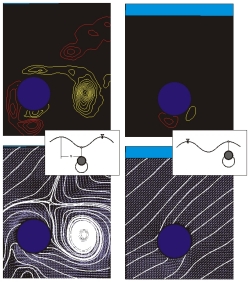Orbital Motion of a Cylinder in a Wave
Peter Oshkai
> Research >
Recent and Ongoing Investigations
Department of Mechanical Engineering > University of Victoria
 Orbital motion of a cylinder in a wave.
A wave having an elliptical particle trajectory interacts with a cylinder subjected to controlled orbital motion. The flow patterns and loading are a strong function of the phase shift between the arrival of the wave crest and the crest of the orbital trajectory of the cylinder. In the left column of images, the phase shift is equal to p while in the right column, it is equal to 0. The pattern of vorticity shown in the left column exhibits pronounced concentrations, including a large-scale negative concentration shed from the upper surface of the cylinder. Correspondingly, the streamline topology exhibits a well-defined focus at the center of the vortex and a saddle point above the cylinder. In contrast, the pattern of vorticity in the right column shows only minor concentrations and the corresponding streamline pattern is dominated by that of the wave. The instantaneous drag force corresponding to images of the right column is very small relative to that for the left column. The wave amplitude H relative to the cylinder diameter D is H/D = 1.57. Ratio of major to minor axis of elliptical particle trajectory of wave is 3:1.
Orbital motion of a cylinder in a wave.
A wave having an elliptical particle trajectory interacts with a cylinder subjected to controlled orbital motion. The flow patterns and loading are a strong function of the phase shift between the arrival of the wave crest and the crest of the orbital trajectory of the cylinder. In the left column of images, the phase shift is equal to p while in the right column, it is equal to 0. The pattern of vorticity shown in the left column exhibits pronounced concentrations, including a large-scale negative concentration shed from the upper surface of the cylinder. Correspondingly, the streamline topology exhibits a well-defined focus at the center of the vortex and a saddle point above the cylinder. In contrast, the pattern of vorticity in the right column shows only minor concentrations and the corresponding streamline pattern is dominated by that of the wave. The instantaneous drag force corresponding to images of the right column is very small relative to that for the left column. The wave amplitude H relative to the cylinder diameter D is H/D = 1.57. Ratio of major to minor axis of elliptical particle trajectory of wave is 3:1.
P. Oshkai and D. Rockwell.
Click here for reference and abstract
poshkai@me.uvic.ca
 Orbital motion of a cylinder in a wave.
A wave having an elliptical particle trajectory interacts with a cylinder subjected to controlled orbital motion. The flow patterns and loading are a strong function of the phase shift between the arrival of the wave crest and the crest of the orbital trajectory of the cylinder. In the left column of images, the phase shift is equal to p while in the right column, it is equal to 0. The pattern of vorticity shown in the left column exhibits pronounced concentrations, including a large-scale negative concentration shed from the upper surface of the cylinder. Correspondingly, the streamline topology exhibits a well-defined focus at the center of the vortex and a saddle point above the cylinder. In contrast, the pattern of vorticity in the right column shows only minor concentrations and the corresponding streamline pattern is dominated by that of the wave. The instantaneous drag force corresponding to images of the right column is very small relative to that for the left column. The wave amplitude H relative to the cylinder diameter D is H/D = 1.57. Ratio of major to minor axis of elliptical particle trajectory of wave is 3:1.
Orbital motion of a cylinder in a wave.
A wave having an elliptical particle trajectory interacts with a cylinder subjected to controlled orbital motion. The flow patterns and loading are a strong function of the phase shift between the arrival of the wave crest and the crest of the orbital trajectory of the cylinder. In the left column of images, the phase shift is equal to p while in the right column, it is equal to 0. The pattern of vorticity shown in the left column exhibits pronounced concentrations, including a large-scale negative concentration shed from the upper surface of the cylinder. Correspondingly, the streamline topology exhibits a well-defined focus at the center of the vortex and a saddle point above the cylinder. In contrast, the pattern of vorticity in the right column shows only minor concentrations and the corresponding streamline pattern is dominated by that of the wave. The instantaneous drag force corresponding to images of the right column is very small relative to that for the left column. The wave amplitude H relative to the cylinder diameter D is H/D = 1.57. Ratio of major to minor axis of elliptical particle trajectory of wave is 3:1.